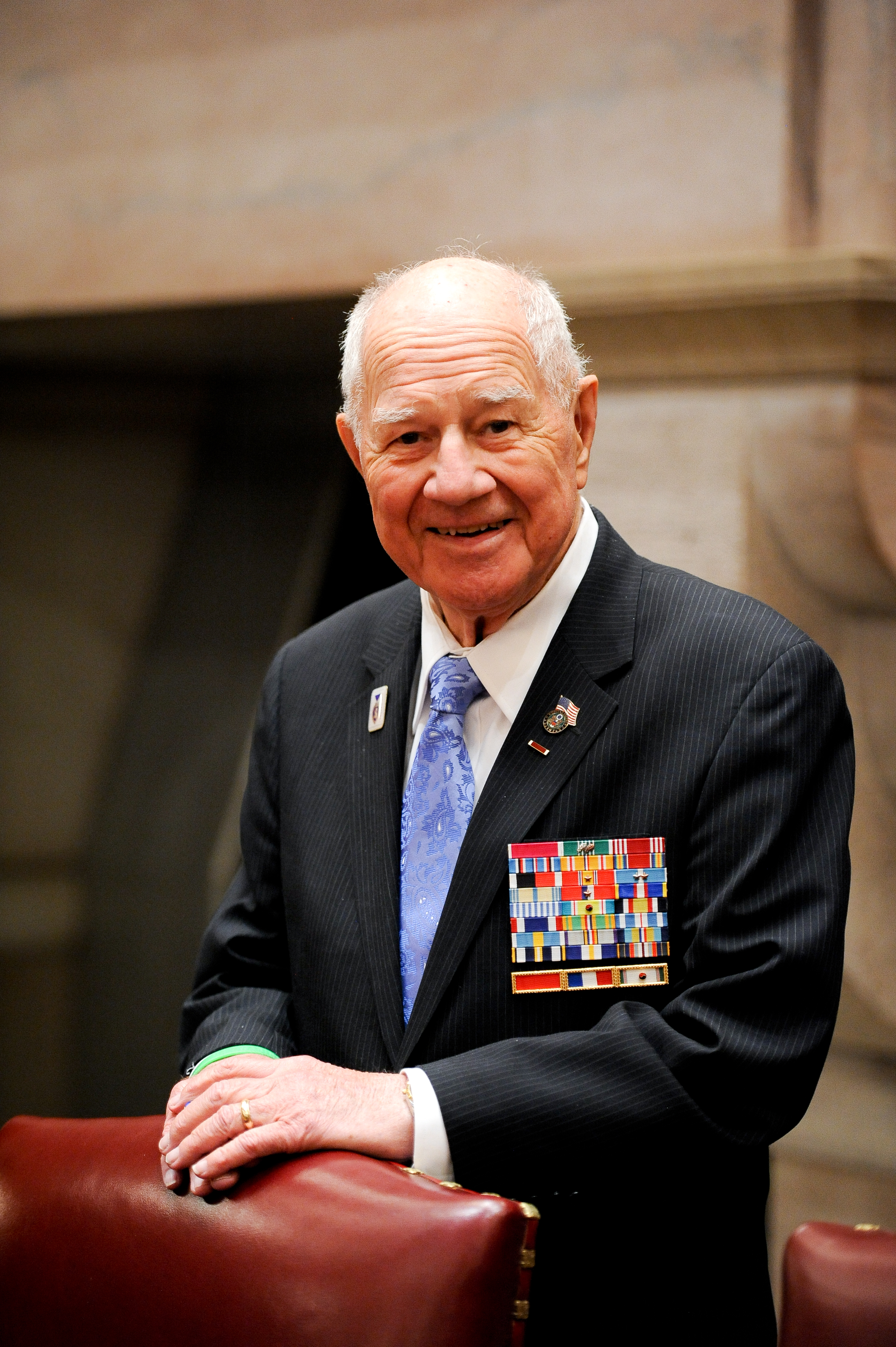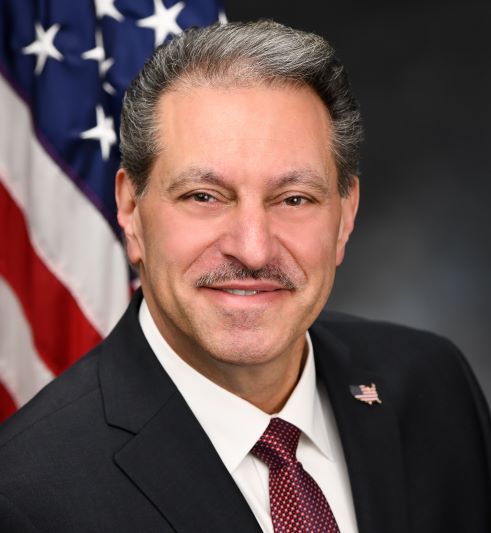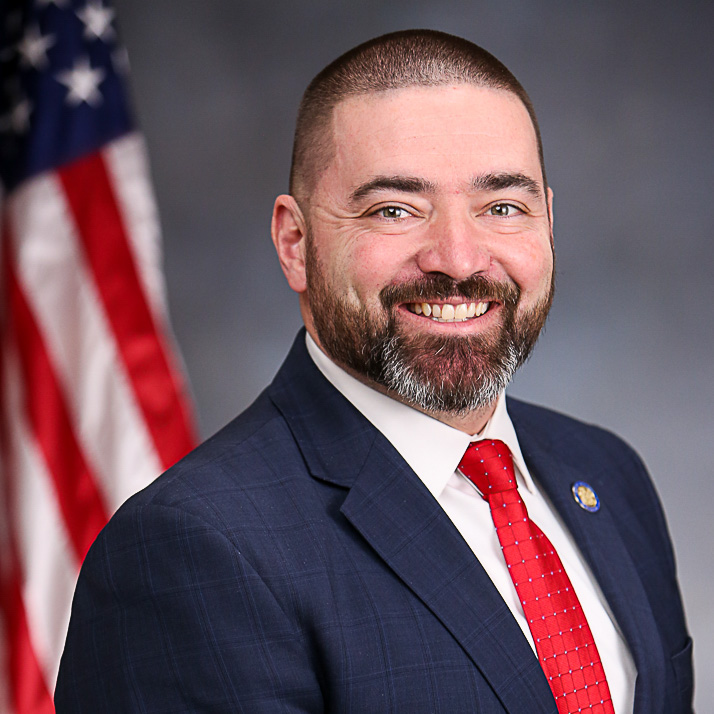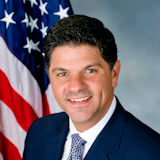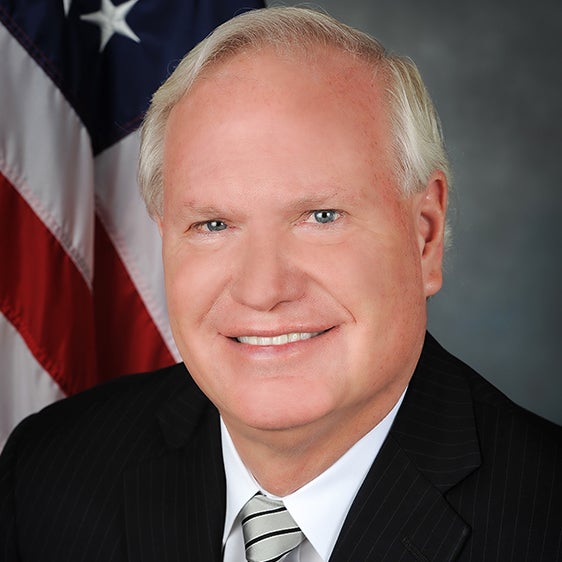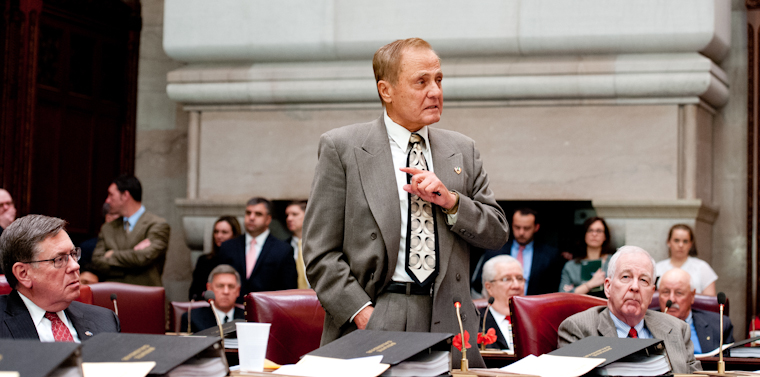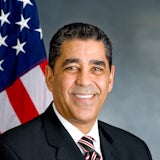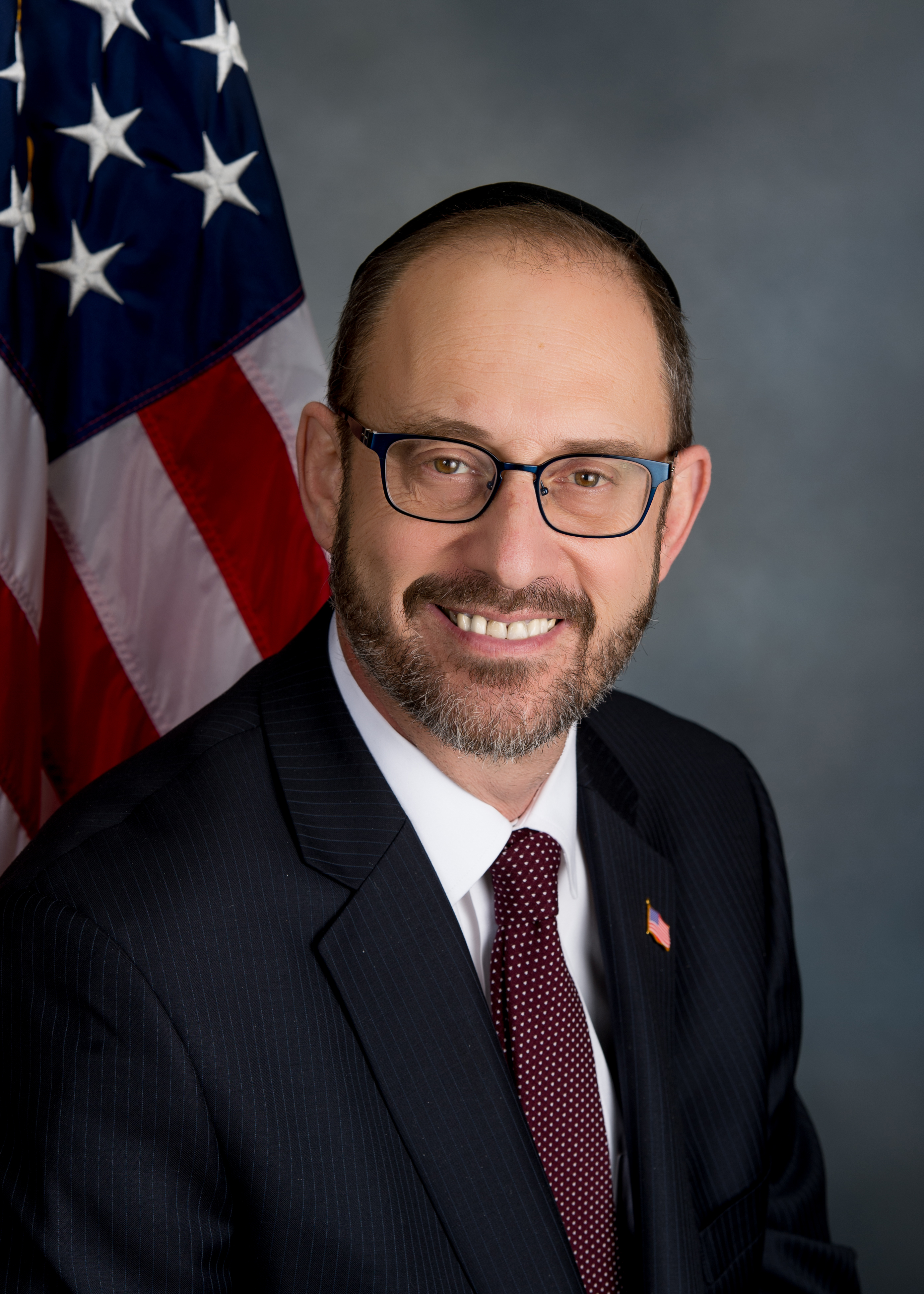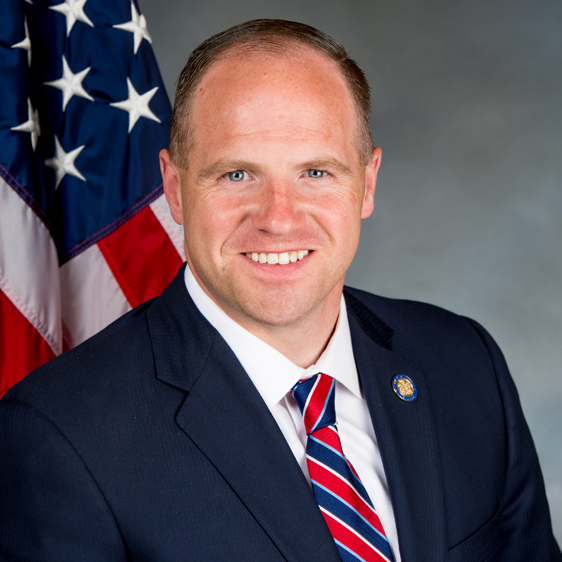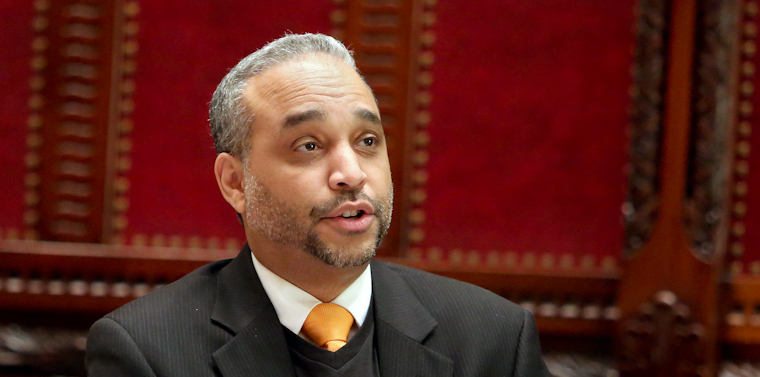S T A T E O F N E W Y O R K
________________________________________________________________________
7160
I N S E N A T E
April 1, 2016
___________
Introduced by Sens. LARKIN, ADDABBO, AKSHAR, AMEDORE, AVELLA, BONACIC,
BOYLE, CARLUCCI, CROCI, DeFRANCISCO, DIAZ, DILAN, ESPAILLAT, FARLEY,
FELDER, FLANAGAN, FUNKE, GALLIVAN, GOLDEN, GRIFFO, HASSELL-THOMPSON,
HOYLMAN, KENNEDY, LANZA, LAVALLE, LITTLE, MARCHIONE, MARTINS, MURPHY,
NOZZOLIO, ORTT, PERALTA, RANZENHOFER, RITCHIE, ROBACH, SAVINO, SERINO,
SEWARD, VENDITTO, YOUNG -- read twice and ordered printed, and when
printed to be committed to the Committee on Finance
AN ACT to amend the retirement and social security law, in relation to
providing credit to members of public retirement systems of the state
for military service; and making an appropriation therefor
THE PEOPLE OF THE STATE OF NEW YORK, REPRESENTED IN SENATE AND ASSEM-
BLY, DO ENACT AS FOLLOWS:
Section 1. Section 1000 of the retirement and social security law, as
added by chapter 548 of the laws of 2000, subdivision 9 as added by
chapter 547 of the laws of 2002 and subdivision 10 as added by chapter
18 of the laws of 2012, is amended to read as follows:
S 1000. Military service credit. Notwithstanding any law to the
contrary, a member of a public retirement system of the state, as
defined in subdivision twenty-three of section five hundred one of this
chapter, shall be eligible for credit for military service as hereinaft-
er provided:
1. A member, upon application to such retirement system, may obtain a
total not to exceed three years of service credit for up to three years
of military duty, as defined in section two hundred forty-three of the
military law, if the member was honorably discharged from the military
[and all or part of such military service was rendered during the
following periods: (a) commencing December seventh, nineteen hundred
forty-one and terminating December thirty-first, nineteen hundred
forty-six; (b) commencing June twenty-seventh, nineteen hundred fifty
and terminating January thirty-first, nineteen hundred fifty-five; or
(c) commencing February twenty-eighth, nineteen hundred sixty-one and
terminating May seventh, nineteen hundred seventy-five;
2. A member, upon application to such retirement system, may obtain a
total not to exceed three years of service credit for up to three years
EXPLANATION--Matter in ITALICS (underscored) is new; matter in brackets
[ ] is old law to be omitted.
LBD07385-11-6
S. 7160 2
of military duty, as defined in section two hundred forty-three of the
military law, if honorably discharged therefrom, if all or part of such
services was rendered in the military conflicts referenced below, as
follows:
(a) hostilities participated in by the military forces of the United
States in Lebanon, from the first day of June, nineteen hundred eighty-
three to the first day of December, nineteen hundred eighty-seven, as
established by receipt of the armed forces expeditionary medal, the navy
expeditionary medal, or the marine corps expeditionary medal;
(b) hostilities participated in by the military forces of the United
States in Grenada, from the twenty-third day of October, nineteen
hundred eighty-three to the twenty-first day of November, nineteen
hundred eighty-three, as established by receipt of the armed forces
expeditionary medal, the navy expeditionary medal, or the marine corps
expeditionary medal;
(c) hostilities participated in by the military forces of the United
States in Panama, from the twentieth day of December, nineteen hundred
eighty-nine to the thirty-first day of January, nineteen hundred ninety,
as established by receipt of the armed forces expeditionary medal, the
navy expeditionary medal, or the marine corps expeditionary medal; or
(d) hostilities participated in by the military forces of the United
States, from the second day of August, nineteen hundred ninety, to the
end of such hostilities in case of a veteran who served in the theater
of operations including Iraq, Kuwait, Saudi Arabia, Bahrain, Qatar, the
United Arab Emirates, Oman, the Gulf of Aden, the Gulf of Oman, the
Persian Gulf, the Red Sea, and the airspace above these locations].
[3] 2. A member must have at least five years of credited service (not
including service granted hereunder) to be eligible to receive credit
under this section.
[4] 3. To obtain such credit, a member shall pay such retirement
system, for deposit in the fund used to accumulate employer contrib-
utions, a sum equal to the product of the number of years of military
service being claimed and three percent of such member's compensation
earned during the twelve months of credited service immediately preced-
ing the date that the member made application for credit pursuant to
this section. If permitted by rule or regulation of the applicable
retirement system, the member may pay such member costs by payroll
deduction for a period which shall not exceed the time period of mili-
tary service to be credited pursuant to this section. In the event the
member leaves the employer payroll prior to completion of payment, he or
she shall forward all remaining required payments to the appropriate
retirement system prior to the effective date of retirement. If the full
amount of such member costs is not paid to the appropriate retirement
system prior to the member's retirement, the amount of service credited
shall be proportional to the total amount of the payments made prior to
retirement.
[5] 4. In no event shall the credit granted pursuant to this section,
when added to credit granted for military service with any retirement
system of this state pursuant to this or any other provision of law,
exceed a total of three years.
[6] 5. To be eligible to receive credit for military service under
this section, a member must make application for such credit before the
effective date of retirement. [Notwithstanding the foregoing provisions
of this subdivision, an individual who retired on or after December
twenty-first, nineteen hundred ninety-eight and before the effective
date of this section may make application for credit pursuant to this
S. 7160 3
section within one year following the effective date of this section, in
which event, the cost to the retiree would be based on the twelve month
period immediately preceding retirement.]
[7] 6. All costs for service credited to a member pursuant to this
section, other than the member costs set forth in subdivision three of
this section, shall be paid by the state and all employers which partic-
ipate in the retirement system in which such member is granted credit.
[8] 7. A member who has purchased military service credit pursuant to
section two hundred forty-four-a of the military law shall be entitled
to a refund of the difference between the amount paid by the member for
such purchase and the amount that would be payable if service had been
purchased pursuant to this section.
[9] 8. Notwithstanding any other provision of law, in the event of
death prior to retirement, amounts paid by the member for the purchase
of military service credit pursuant to this section shall be refunded,
with interest, to the extent the military service purchased with such
amounts does not produce a greater death benefit than would have been
payable had the member not purchased such credit.
Notwithstanding any other provision of law, in the event of retire-
ment, amounts paid by the member for the purchase of military service
credit pursuant to this section shall be refunded, with interest, to the
extent the military service purchased with such amounts does not produce
a greater retirement allowance than would have been payable had the
member not purchased such credit.
[10.] 9. Anything to the contrary in subdivision [four] THREE of this
section notwithstanding, to obtain such credit, a member who first joins
a public retirement system of the state on or after April first, two
thousand twelve shall pay such retirement system, for deposit in the
fund used to accumulate employer contributions, a sum equal to the prod-
uct of the number of years of military service being claimed and six
percent of such member's compensation earned during the twelve months of
credited service immediately preceding the date that the member made
application for credit pursuant to this section.
S 2. The sum of twenty-four million eight hundred thousand dollars
($24,800,000), or so much thereof as may be necessary, is hereby appro-
priated to the department of audit and control out of any moneys in the
state treasury in the general fund to the credit of the state purposes
account, not otherwise appropriated, and made immediately available, for
the purpose of carrying out the provisions of this act. Such moneys
shall be payable on the audit and warrant of the comptroller on vouchers
certified or approved by the head of the appropriate public retirement
system in the manner prescribed by law.
S 3. This act shall take effect immediately.
FISCAL NOTE.-- Pursuant to Legislative Law, Section 50:
This bill would allow up to three (3) years of service credit for
military duty by removing all existing requirements that such military
service be performed during certain war periods, during certain hostil-
ities while in the theater of operations or upon receipt of an expedi-
tionary medal. However, the total service credit granted for active and
peacetime military service shall not exceed three (3) years. Members
must have at least five years of credited service (not including mili-
tary service). Tier 1-5 members would be required to make a payment of
three percent of their most recent compensation per year of additional
service credit granted by this bill. Tier 6 members would be required to
make a payment of six percent of their most recent compensation per year
of additional service credit.
S. 7160 4
If this bill is enacted, insofar as this proposal affects the New York
State and Local Employees' Retirement System (ERS), it is estimated that
the past service cost will average approximately 15% (12% for Tier 6) of
an affected members' compensation for each year of additional service
credit that is purchased.
Insofar as this proposal affects the New York State and Local Police
and Fire Retirement System (PFRS), it is estimated that the past service
cost will average approximately 19% (16% for Tier 6) of an affected
members' compensation for each year of additional service that is
purchased.
The exact number of current members as well as future members who
could be affected by this legislation cannot be readily determined.
ERS costs would be borne entirely by the State of New York. Since a
member can apply for this service credit at any time prior to retire-
ment, a precise cost can't be determined until each member, as well as
future members, applies for the service credit. Every year a cost will
be determined (and billed to the state) based on those benefiting from
this provision.
PFRS costs would be shared by the State of New York and the partic-
ipating employers in the PFRS.
Summary of relevant resources:
The membership data used in measuring the impact of the proposed
change was the same as that used in the March 31, 2015 actuarial valu-
ation. Distributions and other statistics can be found in the 2015
Report of the Actuary and the 2015 Comprehensive Annual Financial
Report.
The actuarial assumptions and methods used are described in the 2015
Annual Report to the Comptroller on Actuarial Assumptions, and the Codes
Rules and Regulations of the State of New York: Audit and Control.
The Market Assets and GASB Disclosures are found in the March 31, 2015
New York State and Local Retirement System Financial Statements and
Supplementary Information.
I am a member of the American Academy of Actuaries and meet the Quali-
fication Standards to render the actuarial opinion contained herein.
This estimate, dated January 14, 2016 and intended for use only during
the 2016 Legislative Session, is Fiscal Note No. 2016-25, prepared by
the Actuary for the New York State and Local Retirement System.
FISCAL NOTE.-- Pursuant to Legislative Law, Section 50:
With respect to certain New York City Retirement Systems (NYCRS), this
proposed legislation would amend New York State Retirement and Social
Security Law (RSSL) Section 1000 to provide certain members of the New
York City Employees' Retirement System (NYCERS), the New York City
Teachers' Retirement System (NYCTRS), the New York City Board of Educa-
tion Retirement System (BERS), the New York City Police Pension Fund
(POLICE) and the New York Fire Department Pension Fund (FIRE), collec-
tively, the New York City Retirement Systems (NYCRS), the opportunity to
obtain additional retirement service credits for certain Military
Service.
This proposed legislation would permit any NYCRS member, prior to the
effective date of retirement, to make application for these additional
service credits.
To obtain such Military Service credits, members would be required to
pay to the appropriate NYCRS, for each year of Military Service
purchased, a sum equal to 3.0% (6.0% for members who first join on and
after April 1, 2012) of such member's compensation earned during the
S. 7160 5
twelve months of credited service immediately preceding the date that
the member makes application for credit.
MEMBERS IMPACTED: Insofar as this proposed legislation relates to the
NYCRS, the number of members who could potentially benefit from this
proposed legislation cannot be readily determined.
IMPACT ON BENEFITS: With respect to the NYCRS, a member who served in
the U.S. military and received an honorable discharge would be permit-
ted, after completing five years of credited service (exclusive of the
service credit that could be purchased under this proposed legislation),
to purchase a maximum of three years of Military Service (inclusive of
any prior purchases of Military Service credit).
In order to purchase the Military Service credits provided in this
proposed legislation, a member must have been honorably discharged
following a period of "military duty" as defined in New York State Mili-
tary Law Section 243.
If a member's Military Service meets these conditions, then that
member would be permitted to purchase a maximum of three years of Mili-
tary Service (inclusive of any previously-received Military Service
credit) attributable to any period of the member's military career.
For purposes of the respective NYCRS, each year of Military Service
credit purchased would apply toward providing the member with a year of
benefit accrual under the particular benefit formula covering the
member.
In certain circumstances, the member also may be entitled to utilize
such Military Service as qualifying service for benefit eligibility
purposes.
For purposes of this Fiscal Note, it has been assumed that members who
purchase Military Service in accordance with this proposed legislation
would generally be entitled to count such service for benefit accrual
purposes and for the purpose of qualifying for benefits.
FINANCIAL IMPACT - OVERVIEW: With respect to an individual member, the
additional cost of this proposed legislation would depend on the length
of all New York City service, age, salary history and Plan in which the
member participates, as well as the number of years of service credit
purchased.
With respect to employers participating in the NYCRS, the ultimate
employer cost of this proposed legislation would be determined by the
increase in benefits to be paid, the impact of certain benefits commenc-
ing earlier and the reduction in certain future member contributions.
FINANCIAL IMPACT - ACTUARIAL PRESENT VALUES: The additional Actuarial
Present Value (APV) of benefits would depend on the number, salaries,
ages and lengths of Military Service purchased by members who would be
affected by this proposed legislation.
With respect to the NYCRS and based on the census data and assumptions
herein, the enactment of this proposed legislation would increase the
Actuarial Present Value (APV) of benefits (APVB) by approximately $147.1
million of June 30, 2016.
In addition, with respect to the NYCRS, the APV of future member
contributions (primarily attributable to the payments by members of 3.0%
(6.0% for members who first join on and after April 1, 2012) of salary
per year of Military Service purchased) would increase by approximately
$22.2 million when measured as of June 30, 2016.
Consequently, with respect to the NYCRS, the APV of net future employ-
er contributions would increase by approximately $124.9 million as of
June 30, 2016.
S. 7160 6
FINANCIAL IMPACT - ANNUAL EMPLOYER COSTS: The ultimate cost of a
pension plan is the benefits it pays. With respect to the NYCRS, the
financing of that ultimate cost depends upon the census data used and
the actuarial assumptions and methods employed. Assuming that all eligi-
ble members were to purchase the eligible Military Service during Fiscal
Year 2016 and based on the Actuary's actuarial assumptions and methods
in effect as of June 30, 2015, the enactment of this proposed legis-
lation would increase annual employer costs by approximately $14.8
million per year.
FINANCIAL IMPACT - EMPLOYER CONTRIBUTIONS: The impact of the proposed
legislation on employer contributions would be a function of the census
data (i.e., age/service/salary, etc.) reported to the Actuary and of
the timing of the members electing to buy back their Military Service.
With respect to the NYCRS, based on the Actuary's actuarial assump-
tions and methods in effect as of June 30, 2015, the enactment of this
proposed legislation would ultimately increase employer contributions by
approximately the estimated additional annual employer costs.
If applications for buying back Military Service were completed during
Fiscal Year 2016 and the NYCRS census data were updated to reflect this
information by June 30, 2016, then employer contributions would first be
impacted for Fiscal Year 2018.
If the Military Service buybacks were completed after Fiscal Year
2016, then the increase in employer contributions would first occur
after Fiscal Year 2018.
FINANCIAL IMPACT - SUMMARY: The following table summarizes the esti-
mated financial impact of this proposed legislation on the NYCRS.
Estimated Financial Impact to Allow Members of the NYCRS
To Purchase up to Three Years of Military Service Credit
($ Millions)
Retirement Additional Additional Estimated
System APV of APV of Future First Year
Benefits Employer Additional
Contributions{1} Employer Costs{2}
NYCERS $51.0 $42.9 $5.1
NYCTRS 15.6 12.8 1.5
BERS 2.2 1.9 0.2
POLICE 61.8 53.0 6.3
FIRE 16.5 14.3 1.7
TOTAL $147.1 124.9 $14.8
{1} Equals increase in APVB minus increase in APV of future member
contributions.
{2} Estimated Additional Employer Costs are determined without regard
to the funded status of the Retirement Systems and represent the best
estimates of the ultimate annual financial burden of the proposed legis-
lation. Estimated Additional Employer Contributions would ultimately
approximate Estimated Additional Employer Costs.
ADDITIONAL EMPLOYER COSTS - GENERAL: In general, the real cost of the
enactment of this proposed legislation would be the additional benefits
paid.
This Fiscal Note does not include analyses of the impact of this
proposed legislation on the expected increases in administrative costs
or costs for Other Post-Employment Benefits (OPEB).
CENSUS DATA: The census data used for estimates of APV of benefits and
employer contributions presented herein are the active members included
in the June 30, 2015 (Lag) actuarial valuations of NYCERS, NYCTRS, BERS,
S. 7160 7
POLICE and FIRE used to determine the Preliminary Fiscal Year 2017
employer contributions.
ACTUARIAL ASSUMPTIONS AND METHODS: Additional APV of benefits, of
member contributions and of employer contributions have been estimated
as of June 30, 2017 using various approximating techniques and assump-
tions by the Actuary, including, but not limited to:
* A certain percentage of Veterans being honorably discharged.
* A certain percentage of honorably discharged Veterans being disa-
bled.
* Different percentages of members by NYCERS having prior Military
Service.
* Each eligible member purchasing an average of 2.5 years of the Mili-
tary Service.
Changes in employer contributions have been estimated assuming the
increase in the APV of Future Employer Contributions would be financed
over a time period comparable to that used for actuarial losses under
the Entry Age Actuarial Cost Method. Using this approach, the Additional
APV of Future Employer Contributions would be amortized over a closed
15-year period (14 payments under One-Year Lag Methodology) using level
dollar payments.
STATEMENT OF ACTUARIAL OPINION: I, Sherry S. Chan, am the Chief Actu-
ary for the New York City Retirement Systems. I am an Associate of the
Society of Actuaries, a Fellow of the Conference of Consulting Actuar-
ies, and a Member of the American Academy of Actuaries. I meet the Qual-
ification Standards of the American Academy of Actuaries to render the
actuarial opinion contained herein.
FISCAL NOTE IDENTIFICATION: This estimate is intended for use only
during the 2016 Legislative Session. It is Fiscal Note 2016-04, dated
March 1, 2016, prepared by the Chief Actuary for the New York City
Employees' Retirement System, the New York City Teachers' Retirement
System, the New York City Board of Education Retirement System, the New
York City Police Pension Fund and the New York Fire Department Pension
Fund.
FISCAL NOTE. -- Pursuant to Legislative Law, Section 50:
This bill would amend Section 1000 of the Retirement and Social Secu-
rity Law to allow active members of public retirement systems of New
York State to claim service credit for up to three years of military
service, regardless of when or where it was performed. Currently, active
members can receive service credit for military service performed, but
only during specified periods of war. A member must have at least five
years of credited service to be eligible and make application for such
credit before the effective date of retirement. To obtain such credit, a
member must make payments as required in Section 1000 of the Retirement
and Social Security Law. Tier 1, 2, 3, 4 and 5 members are required to
pay three percent of salary earned during the twelve months of credited
service immediately preceding the year in which a claim is made for each
year of military service. Tier 6 members are required to pay six percent
of salary earned during the twelve months of credited service immediate-
ly preceding the year in which a claim is made for each year of military
service.
It is not possible to determine the total annual cost of this bill
since the total amount of service credit which would be claimed under
this bill cannot be estimated. Pursuant to Section 25 of the Retirement
and Social Security Law, the cost to the New York State Teachers'
Retirement System (NYSTRS) would be borne by the State of New York and
would require an itemized appropriation adequate to pay the cost of this
S. 7160 8
bill. The cost to the State of New York is estimated to be $19,700 per
year of service credited for Tier 1, 2, 3, 4 and 5 members and $15,200
per year of service credited for Tier 6 members if this bill is enacted.
Each year a cost will be computed and billed to the State of New York
for those members of NYSTRS receiving a benefit under this bill.
Employee data is from the System's most recent actuarial valuation
files, consisting of data provided by the employers to the Retirement
System. Data distributions and statistics can be found in the System's
Comprehensive Annual Financial Report (CAFR). System assets are as
reported in the System's financial statements, and can also be found in
the CAFR. Actuarial assumptions and methods are provided in the System's
Actuarial Valuation Report.
The source of this estimate is Fiscal Note 2016-8 dated February 3,
2016 prepared by the Actuary of the New York State Teachers' Retirement
System and is intended for use only during the 2016 Legislative Session.
I, Richard A. Young, am the Actuary for the New York State Teachers'
Retirement System. I am a member of the American Academy of Actuaries
and I meet the Qualification Standards of the American Academy of Actu-
aries to render the actuarial opinion contained herein.
